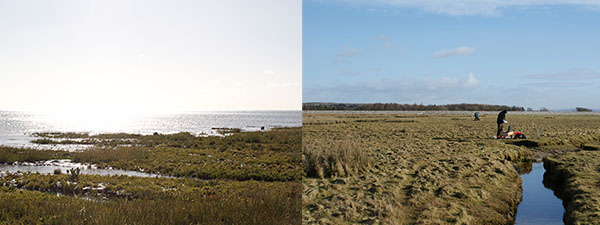A year has gone so quickly, it seems no time at all since we were busy sampling spiders and beetles with our inverted leaf blower and taking huge cores of intact saltmarsh sediment, complete with plant roots and shoots, to use in our shoreline erosion-resistance studies!
As mentioned in the last post from Bangor, Hilary Ford – Bangor CBESS post-doc, visited Groningen University in spring this year to learn how to identify spiders and beetles to species level. As expected, the two main drivers of spider and beetle abundance and diversity are vegetation structure (height, above ground biomass, density, tip height diversity) and salinity. Low-lying, un-grazed Essex salt marshes offered an ideal habitat for invertebrate coastal specialists (salt water lovers) and spiders. In Morecambe Bay, where the tide covers the marsh less frequently than on the south-east coast, beetles (generally less tolerant of salty water immersion than spiders) are numerous, especially where tall vegetation dominates. The ‘best’ marshes overall for spider and beetle diversity were Tillingham Marsh in Essex and West Plain in Morecambe Bay (Figure 1), both structurally complex marshes offering plenty of niches for invertebrates to hide in!

The results of our shoreline resistance to erosion work have proved particularly exciting – watch this space for forthcoming publications. We have found that a suite of biological and soil characteristics influence how quickly tidal currents can erode the saltmarsh edge with soil type, ‘sandy’ or ‘muddy’, soil organic matter and root content being the most important predictors! Sandy soils (Morecambe Bay) tend to collapse quicker than cohesive muddy ones (Essex) (Figure 2) with organic matter and root biomass stabilising the soil regardless of location. Even more surprising is that summer plant species richness clearly limits or ‘buffers’ against erosion in our experimental set up. This is likely to be due to differences in root morphology between different saltmarsh plants with many species creating a complex net of vertical and lateral roots of different depths that help to stabilise the soil. This is one of the first times that this function-diversity pattern has been seen in the field as opposed to a planted plot experiment.

Dr Hilary Ford, Bangor University Postdoctoral Research Assistant
